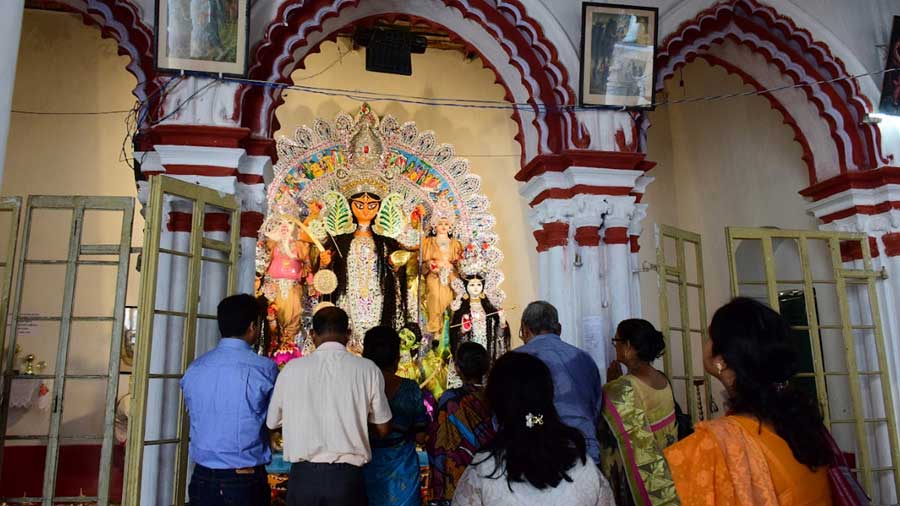Usually, one doesn’t witness any animal sacrifice during Durga Puja in Vaishnava households. However, at the Deb Biswas family of Dasghara, despite the Durga Puja being conducted as per Vaishnavite rituals, as many as four animals are sacrificed and offered to the goddess.
The small village of Dasghara, located under Dhaniakhali Police Station of Hooghly district close to holy place of Tarakeshwar, was once the seat of Baroduari kings about 700 years ago. In his book Hooghly Jelar Purakirti, writer and poet Narendranath Mitra notes that the founder of Biswas family, Jagmohan, settled here after finding favour with Ramnarayan Pal Chowdhury of the Baroduari kings family.
Mitra also mentions that Sadananda Biswas of this family built a five-pinnacled Gopinath temple, studded with exquisite terracotta panels in the year 1729, as evident from the foundation stone. The Biswas family house showcases magnificently built structures like Durga dalan with natmandir, baithak khana and kacharibari along with a dolmancha and rasmancha. These, clustered together on the banks of the pond Gopisagar, make for a pretty picture.
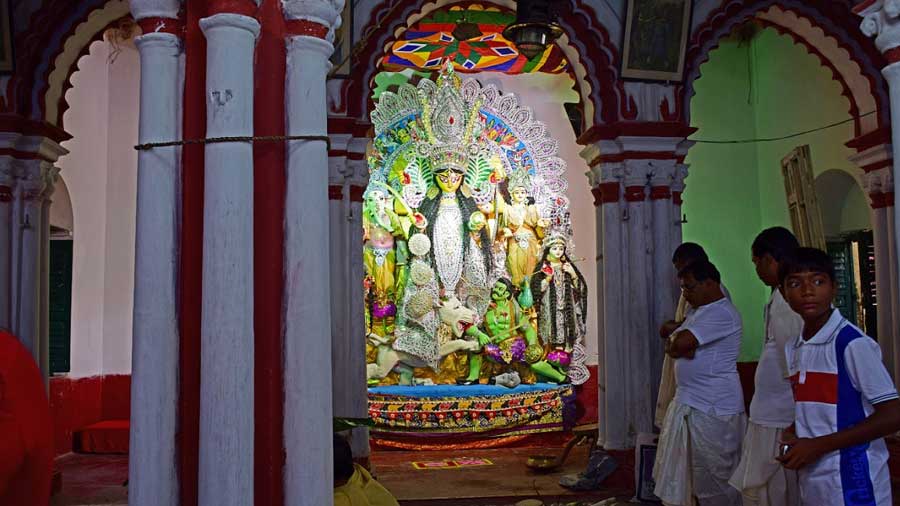
A Durga idol inside Dasghara Deb Biswas family's 'thakur dalan' Amitabha Gupta
According to Rajib Biswas, a senior family member, the family originated from Karnapur of Odisha during the reign of Odiya king, Ananta Burman Chord Gangadev. The original surname of the family was ‘Deb Biswas’, but they now only use the surname ‘Biswas’. The family carried with them a ghaut (sacred urn) of the Goddess Chandi, which was the family deity. This was placed with great reverence on a ‘Pancha Mundi Asan’ — an altar with the skulls of five different animals and housed in a temple. Rajib informed that the 18th century-built Durga dalan of today stands at this very place.
The influence of Sri Chaitanya Mahaprabhu saw the entire Deb Biswas clan embrace Vaishnavism during the 16th century. The Chandi ghaut worship continued till the mid- eighteenth century when Sri Sri Radha Gopinath Jiu was installed as the family deity. The Chandi ghaut was then shifted and installed at the ‘Gurukul’ in Goswami Malipara, Hooghly. The religious heads of the family decided to conduct only the autumnal Durga Puja in clay idol form at Dasghara.
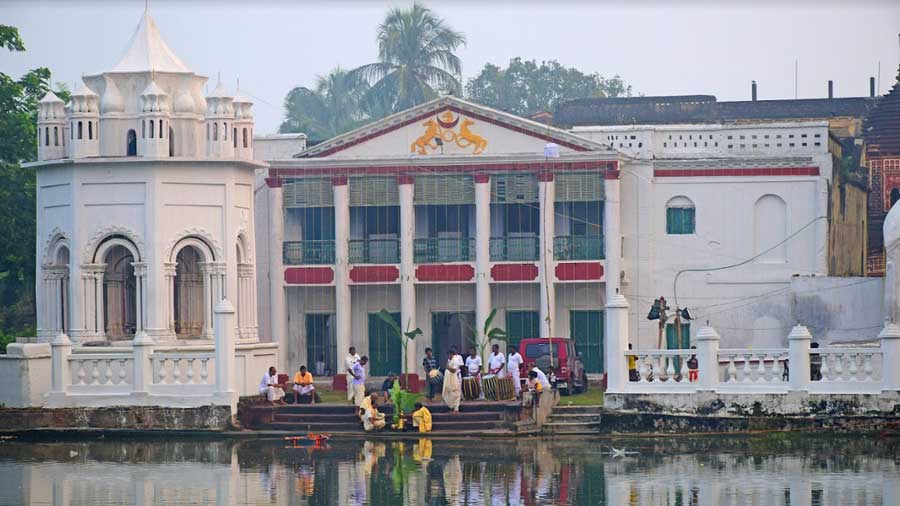
The palatial 'kacharibari' housing the 'Durga dalan' Amitabha Gupta
The unique part of the Durga idol of the Biswas family is that the deity has four arms holding sword, shield, trident and snake — instead of the usual 10 arms. Kartik and Ganesh are placed above Lakshmi and Saraswati on the Chalchitra or Chali. This form of Durga gives an indication of the Odiya roots of the Deb Biswas family. Lord Ganesh has just two arms without any weapons in his hand. This is reminiscent of the Maharashtrian ‘Chintamani Ganesh’, which according to Rajib Biswas, might be an influence from Maratha Bargis.
From the day of Pratipada, the Chandi ghaut is reinstated by the Biswas family as their original family deity. It is placed on the same altar as Goddess Durga, where the deity used to originally stand. It is placed to the left of the Durga idol. On the night of ‘Maha Sashthi’, ‘Naba Patrika’ is stored inside Lord Gopinath's kitchen, which indicates it was a practice introduced later as it is not a prerequisite in the daily worship of Durga or Chandi.
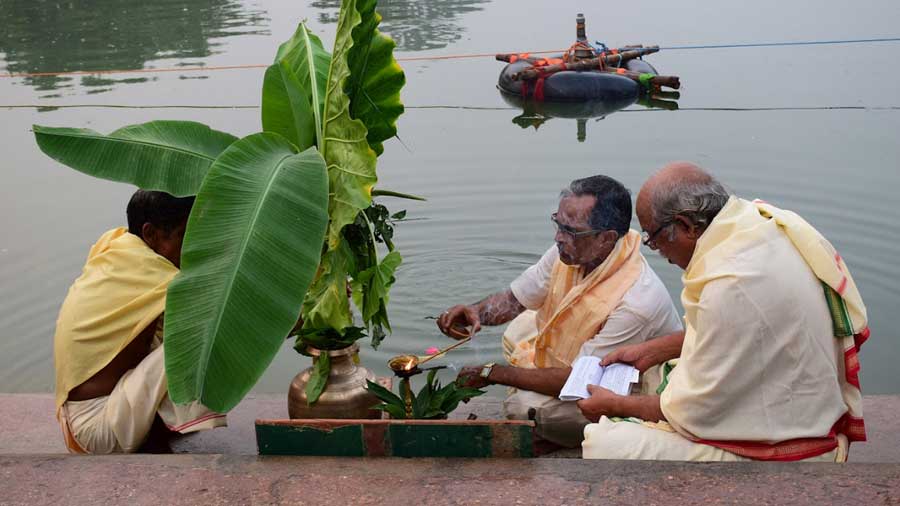
'Naba Patrika' rituals beside the waterbody Gopisagar Amitabha Gupta
Also, because of daily worship of Debi Chandi’s ghaut at the Gurukul in Goswami Malipara, the traditional ritual of “Chir Kathi’, or placing of sacred twigs to bind and impart divinity to the deities during the duration of Durga Puja, is not required as it is considered to be a continuation of the daily worship of Goddess Chandi.
Usually, Vaishnav families refrain from rituals involving violence and bloodshed. The Biswas Bari Durga Puja stands in sharp contrast to this as its rituals involve animal sacrifices on Maha Saptami, Sandhi Puja and Maha Navami (two sacrifices on this day) as the puja is done here following Shakta rituals. This is a clear indication to the family’s pre-Vaishnavite, Shakta heritage. However, after conversion to Vaishnavism, the family members do not consume the ‘Maha prasad’ from this ritual. The local potter and blacksmith divide the prasad amongst themselves. One sacrificed goat is given to the priest.
It is worth mentioning here that Sri Sri Gopinath Jiu and Radha Rani are laid to sleep before the blood sacrifices and their ears are plugged with cotton wool. Their temple doors are kept shut. Such animal sacrifice also takes place at Bimala Mandir during Durga Puja, located inside the Jagannath Temple complex in Puri, Odisha.
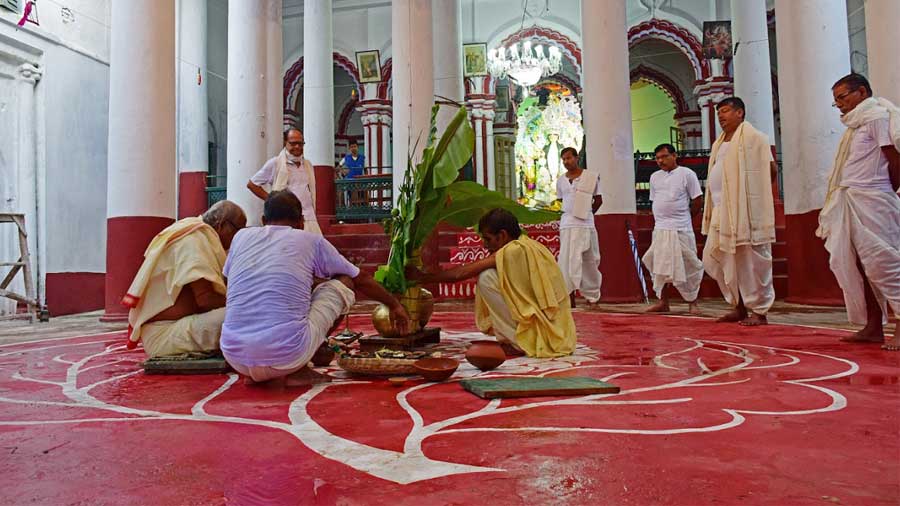
'Naba Patrika' rituals being performed in front of the 'thakur dalan' Amitabha Gupta
The goddess is offered 30-40 types of Naibadya (uncooked food offerings). Other offerings include luchi, sweets and fruits.
On Dashami, the idol is immersed in the Gopisagar pond in front of the mansions. Just prior to the immersion, the crown of Durga is removed and later dispatched to Kali Temple at Tirol near Arambagh.
Family legend has it that many years ago, a beautiful little girl, professing to be a daughter of the Biswas family of Dasghara, appeared before a sage who established the mandir and bid him to conduct a Kali puja. After the ceremony, no trace of the girl was found, except for her Sinthi More (forehead jewellery). It was since believed that the girl was actually an incarnation of the Goddess.
Amitabha Gupta is a travel writer and a photographer who specializes in heritage and history of West Bengal. His work has been featured in many magazines and newspapers — both online and offline. He also conducts heritage walks and tours in and around Kolkata.
